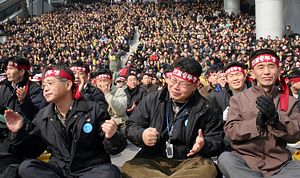New government data reported last week by Yonhap show that among all wage earners, 6.2 million of them (32.5 percent of the total workforce) are “irregular” workers. This marks a new high, a o.01 percent increase from 2014, and a 5.1 percent increase from 2002, when the government started collecting data on this category of employment
But what, exactly, is irregular labor and why does it matter?
The paid labor force in South Korea is divided into two categories: regular and irregular. According to attorney S. Nathan Park, who explained the difference in a February op-ed for the now-defunct Korea Real Time, these terms “are shorthand rather than precise legal definitions. Broadly speaking, a regular worker is a worker who receives the fullest benefits afforded by Korea’s labor laws; an irregular workers is a worker who does not.” The latter could be anything from a sub-contracted worker doing a one-off job to an office worker on a short, two-year contract.
Irregular workers are, in short, precariously employed people. What makes them precarious, Park indicates, is that they aren’t guaranteed the “’four major insurances’” that corporations are legally obligated to provide regular workers — health insurance, occupational hazard insurance, unemployment insurance, and the national pension. These insurances were the legal accomplishments of the labor unions’ post-1987 democratic transition legal victories.
Additionally, and perhaps most importantly, irregular workers aren’t guaranteed employment unlike regular workers. The latter category of employment, Park adds, “cannot be subject to a defined end date of their employment other than the mandatory retirement age, nor can they be terminated without cause.”
The unions’ legal victories were seriously curtailed by the structural adjustments implemented in response to the 1997 Asian Financial Crisis, which sought to make the labor market more flexible and South Korea’s large conglomerates more nimble. The reforms signaled a transition to a new era of business – specifically chaebol – dominance. While the state may have reigned supreme in the developmental era and the decade after the democratic transition, capital now assumed the position of head honcho.
The transition to a fully liberal-democratic mode of governance (what many would describe as the triumph of “neo-liberalism”) has brought with it all the things that trouble many other liberal-democracies. Chief among them? Rising inequality.
As Professor Hagen Koo points out, “economic inequality increased noticeably during and after the [1997] crisis. South Korea’s average Gini coefficient – a measure of inequality – for 1990-1995 was 0.258, but with rising inequality its coefficient increased to 0.298 in 1999, two years after the onset of the financial crisis.” The Gini coefficient is intended to measure the distribution of income in a country; 0 would mean complete quality and 1 completely inequality. In 2013, South Korea’s Gini coefficient stood at .307, according to the OECD.
This trend of rising inequality shows no signs of abetting. According to the same Yonhap article cited above, “The average monthly income for irregular workers is 1.4 million KRW [about $1,200], less than half that of regular workers (2.6 million KRW). The income gap increased. When wages increased by 3.5 percent for regular workers, irregular workers’ pay only increased by 1 percent.”
Comparative data show South Korea is significantly more unequal than a country like Denmark and more equal than a country like the United States. But it’s the trend that worries many. Life is seemingly getting harder, opportunities for upward mobility less, and regular employment harder to come by.
Who are these Koreans coming of age in this era of uncertainty? Some would draw a line between worsening economic conditions and the “Give up” generation, and such a correlation is not unwarranted. The future is most uncertain.

































